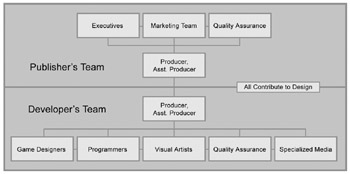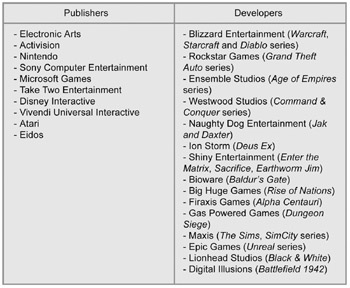Developer s Team
|
| < Day Day Up > |
|
Team Structure
The diagram in Figure 12.1 lists the basic job categories that make up most development and publishing teams in the game industry today. Note that this diagram only shows the types of individuals who are involved in the production at some level. We purposely did not include human resources, accounting, public relations, sales, and support, as they don’t typically become involved in the actual production and are outside the scope of this discussion.

Figure 12.1: Team Structure
Publisher versus developer
To understand team structure, we must first examine the relationship between the publisher and the developer. As any game developer can tell you, this relationship is critical. It determines how everything else will be structured. The types of relationships vary. Sometimes the developer will do almost everything but sell and market the game. Other times, the publishers will pick up much of the development and internalize it, utilizing the developer only for specific tasks. But in most cases, the arrangement will break down according to the chart in Figure 12.2.
Typically, the publisher gives the developer an advance against royalties, and the developer uses this money to pay the team members, cover overhead, and subcontract certain portions of the work. The developer’s main task is to deliver the product, while the publisher’s is to finance and distribute it.
Figure 12.3 shows examples of some typical publishers and developers in the industry today. One confusing aspect of this relationship is that many game publishers also develop games internally. Electronic Arts is one example of a publisher that develops a number of its titles in-house. Additionally, some game developers are owned by publishers. For instance, Blizzard Entertainment is wholly owned by Vivendi Universal Games.
Even in these cases, however, there’s a basic publisher/developer relationship between the internal development group and the rest of the company. In many respects, in-house development teams, as they’re called, are forced to act like small companies, responsible for their own cash flow, profit and loss, schedules, and staffing. This helps the publisher to gauge the success of each developer and analyze whether it’s more cost effective to work with internal or external groups.
We’ll look at the typical individuals involved in a game production from the publisher’s side on page 334, but first, let’s focus on the production team from the developer’s perspective.

Title: Producer, NCSoft
Project list (five to eight top projects)
-
Tabula Rasa (in production): Producer
-
Ultima Online: Project Director
-
Bioforge: QA Lead
-
Ultima VIII (French): QA Lead
-
Wing Commander: Privateer: QA
-
Wing Commander: Armada: QA
-
Ultima Underworld 2: QA
-
Ultima VII: Part 2: Serpent Isle: QA
How did you get into the game industry?
I was working in theatre in Austin (I have a degree in set/lighting/sound design) and not making very much money. I needed a steadier income so I answered an ad in the local paper that said Origin was looking for playtesters. I have always loved games of all kinds and I had no idea that people actually got paid to play games. I got the job and went on to project direct Ultima Online, the first large-scale success in online gaming.
What are your five favorite games and why?
-
Diablo II: I have spent more time playing Diablo II than any other game. The game is very simple but incredibly deep. The item and monster generation in this game are some of the best ever. Each time I play I find some new combination of weapon attributes or boss monster abilities. When combined with the multiplayer aspect there are few games that can match this one. They also have provided stellar support over many years on Battle.net. I still play to this day.
-
Grand Theft Auto: Vice City: The immersive quality of this game has no equal. The possibilities the designers built into the game for emergent behavior are almost limitless. Being able to solve almost every single mission in a myriad of ways (drive-by shooting versus sniper, moped versus semi, etc.) was thrilling. Just driving or flying around the game was fun. To top it all off the radio station soundtrack of 1980s tunes was a stroke of genius.
-
Tony Hawk Pro Skater: I attempted to be a skater when I was young but alas I am neither coordinated nor athletic so I was terrible. This game let me do all the tricks I could never do in real life. It also introduced me to the idea of multiple objectives within a given game context (skate parks in this game), which I have used as a model in the game I am currently working on.
-
Command & Conquer: The first real time strategy game to truly leverage multiplayer. While the game only had a few units compared to recent titles each of those units was very differentiated so strategies from session to session could vary immensely. They also nailed the luck factor through their “crates” so it was possible to come back and win even if you fell really far behind. To this day I have yet to see another RTS that you can come back from behind like this.
-
Ultima IV: Quest of the Avatar: The first role-playing game where what you did in the game actually mattered. You could not just go around killing and stealing to win the game. You really had to be a good guy by following the virtues or else the game would become un-winnable. A game with a conscience if you will.
What games have inspired you the most as a designer and why?
-
DOOM: This game was the first to really open my eyes to the possibilities of multiplayer games. For the first time I truly understood how human beings were infinitely more entertaining and unpredictable than any artificial intelligence. This game more than any other was my inspiration
-
Diablo: Diablo showed me how an incredibly simple game mechanic in an RPG could be so captivating. The mechanics of starting up games with small groups and having that play space to yourself is what has inspired the focus on instantiated spaces in my current project.
-
Tony Hawk Pro Skater: Placing multiple objectives in a single game context was brilliant. This inspired how we are building missions in my current project to encourage replay.
What are you most proud of in your career?
-
Starting in QA
-
I am most proud of the fact that I worked my way up from the very bottom of the organization to leading multi-million dollar projects. The perspective I gained from having to test broken games informed every aspect of how I make games today. My QA experience inspired my mantra: “Stable, fast, and fun. In that order.”
-
Ultima Online.
-
UO started out as the bastard child of EA/Origin. At one point they had us sitting in a hallway while they were remodeling an entire floor of the building around us. Despite the hardships I supported my team and kept us going. The result was the first large-scale success in online subscription based gaming. However what made me most proud was a letter we received from a physically challenged individual who thanked us for giving him an alternate world that he could live in where he could run.
What words of advice would you give to an aspiring designer today?
Play every game you possibly can. Then analyze them carefully. Ask yourself what you would change if you could. Figure out what feature was best executed and which one was the worst executed. Finding inspiration from outside of games is extremely important. Read books, watch movies, see plays, look at art, listen to music, watch people interact with each other—there is inspiration everywhere. We take books and mark passages for directing level design. We show each other clips from films for art direction ideas. Finally always make sure you are having fun. If you are not having fun making your game, then your customers will not have fun playing it.

Figure 12.2: Publisher/developer responsibilities

Figure 12.3: Example publishers and developers
|
| < Day Day Up > |
|
EAN: 2147483647
Pages: 162